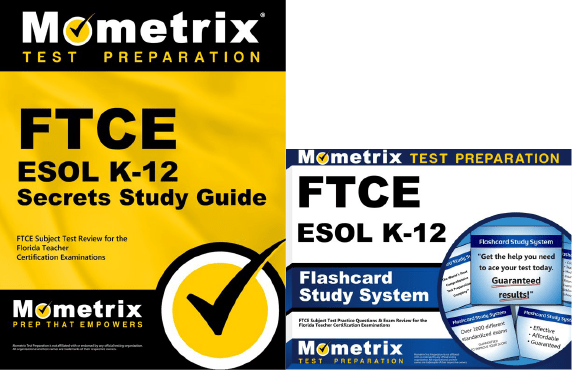If you need help studying for the FTCE ESOL K–12 test or just want some more information about what the test is like, you’ve come to the right place!
Click below to take a free FTCE ESOL K–12 practice test!
What’s on the Test?
The FTCE ESOL K–12 test contains 80 multiple-choice questions and is timed at 2.5 hours.
The exam is split into nine competencies:
1. Culture as a Factor in ELLs‘ Learning
12% of the exam
- Elements of culture and their impact on instruction
- The impact of ELLs’ culture on participation and learning
- Phases and characteristics of cultural adaptation
- Obtaining information about the cultural background and experiences of ELLs
- Fostering multicultural sensitivity and inclusivity
- Identifying ways school-home connections build partnerships with ELLs’ families
- Social issues and trends that may affect learning
2. Language as a System
10% of the exam
- Phonology and morphology principles
- Semantics and syntax
- Pragmatics and discourse
- Obtaining information about the home languages of ELLs
3. Language Acquisition and Development
14% of the exam
- Major theories and processes of first- and second-language acquisition
- Factors that influence the development of bilingualism and biliteracy
- Identifying how ELLs’ literacy and oracy in the home language serve as a foundation for learning English
- Characteristics of academic and social language
- Language functions of spoken and written English
- Characteristics of ELLs with exceptionalities
- Characteristics of ELLs who are gifted and talented
4. Second Language Literacy Development
10% of the exam
- Current theories of second-language reading and writing development
- The influence of an ELL’s L1 oral language on English language skill development
- The influence of an ELL’s L1 literacy and home literacy practices on English language skill development
5. ESL/ESOL Research, History, Public Policy, and Current Practices
10% of the exam
- Past and present approaches to ESOL instruction
- Major researchers and their influence on best practices
- Major court decisions, laws, and policies that affect ELL education
6. Standards-Based ESOL and Content Instruction
10% of the exam
- Instruction that develops English listening and speaking skills
- Instruction at varying English proficiency levels
- Developing authentic uses of English language and literacy
- Incorporating ELL’s funds of knowledge to facilitate content area learning
- Adaptations of curricular materials and modification of instruction
7. Resources and Technologies
10% of the exam
- Culturally responsive and linguistically accessible materials
- Incorporating technological resources and digital tools
- Effective means of collaboration with school-based, community, and district resources
- Major resources and organizations that support continuing education for teachers of ELLs
8. Planning Standards-Based Instruction of ELLs
10% of the exam
- Appropriate language objectives
- State-approved content-based standards
- Planning instruction for ELLs with prior formal educational backgrounds
- Characteristics of collaborative classroom environments
- Appropriate methods of differentiation for ELLs’ learning
8. Language Proficiency Assessments, Classroom-Based Assessments, and Assessment Issues for ELLs
14% of the exam
- Federal, district, and state requirements for identification, reclassification, and exit of ELLs from ESOL programs
- Interpreting results from assessments to guide instruction
- Communicating with stakeholders
- Proper use of alternative assessments and instruments
- Adapting assessments according to ELL’s proficiency levels
- Factors that affect the reliability and validity of assessments
- Assessments that measure progress in academic achievement, oral language, and literacy
- Accommodations during assessments
How to Register
To get started with the registration process, you’ll need to create an FTCE/FELE account on their website. You can then register for the exam via your account.
The testing fee is $150.
How the Exam is Scored
The FTCE ESOL K-12 test is scored using a scaled scoring method. Here’s how it works:
For every question you answer correctly, you get one point added to your raw score. At the end of the test, your final raw score will be converted to a scaled score. You’ll need a scaled score of at least 200 to pass the exam.
The reason your raw score is converted to a scaled score is because everyone that takes the test is given a slightly different set of questions. Since everyone has a different arrangement of questions, and because some questions are harder than others, converting your raw score to a scaled score ensures a more even playing field.
FAQs
How many questions are on the FTCE ESOL K-12 exam?
The exam contains 80 questions.
What is the time limit for the FTCE ESOL K-12 exam?
The exam is timed at 2.5 hours.
What is the passing score for the FTCE ESOL K-12 exam?
You’ll need to get a final scaled score of at least 200 to pass.
How much does the FTCE ESOL K-12 exam cost?
The testing fee is $150.



 FTCE Study Guide
FTCE Study Guide FTCE Flashcards
FTCE Flashcards